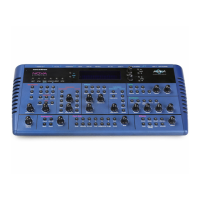Delay Time. This parameter controls the amount of time it takes for the delayed signal to be heard after the original signal. In the
example given above this is the same effect as the distance you are from the wall. A large distance produces a long delay & a
short distance produces a short delay. In the Nova, the Delay time is the time of the Longest delay. The shorter delay will be a per-
centage of this value ( See “Ratio” below ).
Feedback. This parameter controls how much of the delayed signal is fed back into the delay’s input. No feedback produces a
“Slapback Echo” effect, that is just one delayed signal with no repeats. Small amounts of feedback produce “repeated” signals giv-
ing the “Echo” effect. This can be thought of as standing in-between two parallel concrete walls. The sound bounces back & forth
between them. In this case the Decay Time represents the distance between the walls.
HF Damping. HF Damping is short for High Frequency Damping. This controls the “tone” of the decaying Echo. This can be
thought of as the amount of drapes on the walls. Drapes tend to absorb high frequencies, so as a sound “bounces” from wall to
wall giving you your Echo effect, with each bounce the sound looses a little treble. No HF Damping is a little unusual in the “real”
world but can be used to emphasise sibilant or trebly sounds. This characteristic was found in older “Tape” based echo units.
Higher values of this parameter simulates the effect of worn out tape or heads in a tape echo. Normally a little HF Damping is
applied to give the Echo a natural kind of sound.
Ratio. The Ratio parameter automatically adjusts the “Ratio” of the longest Delay time & the shorter Delay time into timings that are
useful for Musical use. This parameter does not effect the Delay Time parameter but does alter the shorter Delay time so that it
works well with the Delay Time setting.
Width is the Stereo spread between the long & shorter Delay times. When set to 0 width both delays appear in the middle of the
stereo field (Mono). At a width of 127 the long delay will appear on one output & the shorter delay on the other producing a dramat-
ic stereo effect.
Pan.
This effect controls where the sound “sits” in the stereo field. In the Nova this performs exactly the same function as Pan does on a
Mixing console. It can be used to statically position a sound anywhere from Left to Right in the stereo field. This ( as everything
else on Nova ) can be controlled via MIDI controllers.
Pan Type determines if the Pan is set to Pan automatically. If set to “Autopan” the sound will swing from side to side of the stereo
field at a rate determined by the Speed parameter. If set to “Tremolo” the sound goes up & down in volume at a rate determined by
the Speed parameter.
Speed determines the speed of the Autopan & Tremolo effects.
Depth determines how much the Autopan & Tremolo effects control the Volume of the sound, small amounts produces subtle
movements & full amount produces change from no sound to full volume.
Vocoder.
The Vocoder effect allows your Nova to speak. What it actually does is it transfers the spectrum of any incoming signal from either
Audio Input onto any internal or external sound. A typical use is to use a Microphone signal as the “Modulator” ( that is the sound
the spectrum will be copied from ) & place the same characteristics onto an internal sound. ( this sound is called the “Carrier” )
When the Vocoder button is pressed, the knob in the effect section becomes an elegant Balance control between the Un-vocoded
“Carrier” when fully anticlockwise, the Vocoded “Carrier” in the mid position & the “Modulator” in the fully clockwise position. This
allows a variety of mixes to be achieved.
A special High Pass Filter is included in the vocoder to transfer harmonics that are rarely found in normal keyboard type sounds
from the “Modulator” to the “Carrier”. The level of the output of this filter is controlled with the “Sibilance level” parameter & when
this is turned up, the Sibilant ( Trebly ) elements of the “Modulator” are added to the “Carrier” signal.
Sibilance can be further modified using the “Sibilance type” parameter. This either filters the sibilant elements from the “Modulator
when set to H ( High ) Pass or artificially uses Noise to do this job if set to Noise. When this is set to Noise, the Sibilance can not
only be Trebly but also Bassey. This can be very effective when using things like Drum Loops as the “Modulator”.
ABOUT EFFECTS
19

